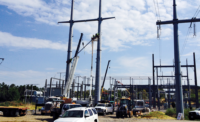Key Crossing Reliability Initiative
Baltimore
BEST PROJECT
Submitted By: Burns & McDonnell
Owner: Baltimore Gas & Electric – Exelon
Program Manager: Burns & McDonnell
Lead Design Firm: Sargent & Lundy
General Contractor: McLean Contracting Co.
Civil Engineer: Moffatt & Nichol
Structural Engineer: Valmont
The two-year program was designed to ensure Baltimore Gas & Electric (BG&E) will continue to deliver safe and reliable power to more than a million customers in the Baltimore region for the next 75 years, according to Burns & McDonnell. The focus was addressing two high-voltage transmission circuits located beneath the Patapsco River on the north side of the Francis Scott Key Bridge, where 1970s-era cabling had reached the end of its service life. Following lengthy coordination with environmental and utility regulatory agencies and extensive stakeholder outreach, BG&E elected to replace the aging underwater infrastructure with a 230-kV overhead transmission line.
Design of the power line’s support structures addressed aesthetic considerations such as minimizing impacts on views from the bridge and nearby Fort McHenry, the setting for the battle that inspired “The Star Spangled Banner” poem. The iterative process led to the choice of tall, slender monopoles that would prove more cost-effective to construct and minimize hazards to vessels navigating Baltimore’s international commercial shipping channel.

Photo courtesy KGDR Consultants
After undergoing a specialty fit test in an offsite warehouse to ensure proper fit, monopole sections were galvanized to prevent corrosion from long-term exposure to the harsh marine environment. A dull colored coating reduces the towers’ glare and visibility from a distance. The towers were installed through a carefully sequenced process that meshed with shipping traffic. A bubble curtain was implemented during in-water, pile-driving operations to mitigate sound wave propagation, avoiding harm to nearby aquatic life.
Each in-water tower foundation was fitted with an independent vessel collision protection (VCP) structure composed of layers of precast and cast-in-place concrete supported by steel pipe piles. A plastic lumber fendering system installed around the perimeter of the VCP structures will further reduce vessel impact energy. Dive inspections of completed tower foundations and protective structures ensured any visible construction-related defects were identified and repaired.

Photo courtesy KGDR Consultants
Where possible, the project team incorporated precast concrete elements incorporated into design concepts for in-water structures. Along with helping speed the construction process, the approach extended the design life of the reinforcement and minimized the need for cast-in-place concrete formwork. That provided another safeguard for the sensitive marine environment. In addition, the team safely removed more than 165,000 gallons of dielectric mineral oil from the existing underwater cable system.
A complex, carefully coordinated outage sequence maintained reliable electric service to BGE customers during the construction of the new overhead infrastructure. Strategic planning and teamwide collaboration enabled the project, whose cost was not disclosed, to be completed 15 months ahead of schedule and significantly under budget.

Photo courtesy KGDR Consultants





